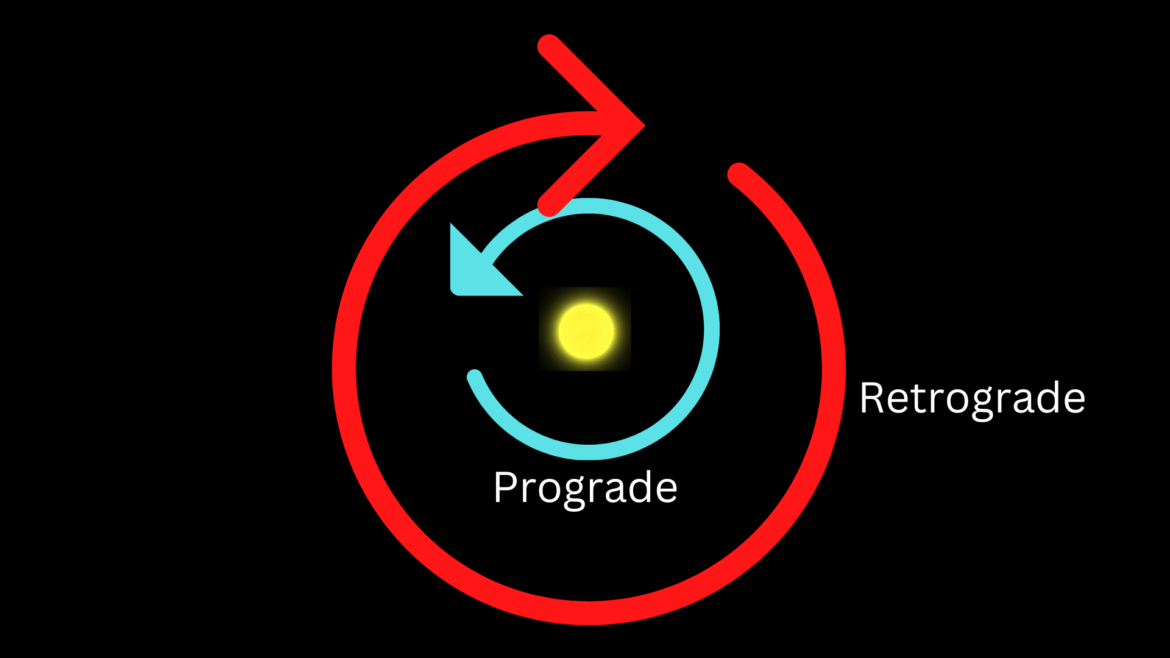Do you know that some objects orbit the Sun backward? In this article, we’ll talk about retrograde motion and how it occurs in this article.
Apparent Retrograde Motion
First of all, if you talk about the planets orbiting the Sun in retrograde, they’re not really orbiting backward. In fact, all planets in our Solar System orbit prograde, which means they orbit in the same direction as the Sun’s rotation. But how do planets move backward as seen from Earth or any other planet?
If the planet you’re seeing is farther from the Sun than you are, it appears to go back when you pass it. When you start passing the planet, the viewing angle shifts in the normal direction. However, due to the spherical nature of the orbits, when the planets begin to align, the angle of the planet in the sky moves toward the line between the Sun and the two planets. This is apparent retrograde motion, as the planet’s motion in the sky exceeded that centerline before the overtake. It will continue moving backward until some point, after which it starts moving the usual way again. This phenomenon is not easy to explain with words, so the image below may help you understand how it works.
By Original: Unknown Vector: Rursus – Own work based on: Retrogadation.png, CC BY-SA 3.0, https://commons.wikimedia.org/w/index.php?curid=7119751
Retrograde Motion
All celestial objects that orbit the Sun beyond our orbit will go backward from time to time, but do you know that some objects go backward all the time? That’s because they’re genuinely going the opposite way relative to our Sun. This is retrograde motion and is defined as the motion of an object against the rotation of its parent body. In more mathematical terms, a retrograde orbit is an orbit with an inclination higher than 90 degrees.
Some asteroids do orbit retrograde relative to our Sun. However, they are rare. In fact, out of the 726 thousand asteroids discovered as of 2017, less than a hundred orbit retrograde. One weird example is 514107 Kaʻepaokaʻawela (2015 BZ509), which is co-orbital with Jupiter but orbits the Sun backward! This is known as a 1:-1 resonance, in contrast to the 1:1 resonance for prograde orbits, and is very rare among the interactions between asteroids and planets.

The orbit is quite inclined relative to the Sun (around 17 degrees from the ecliptic), and its inclination is 163 degrees, which indicates a retrograde orbit.
Credit: NASA/JPL Small-body Database
However, there is a much richer source of retrograde objects in our Solar System — outer moons. When you look at the dynamics of the moons in our Solar System, most small outer moons, especially those of Jupiter and Saturn, orbit retrograde. Let’s explore how they reached this position in the next section.
Why Do Some Planets and Moons Orbit Retrograde?
Prograde motion is the usual way of orbit because of the way celestial objects form. There is an accretion disk of material at the beginning, which spins in one direction. This includes the matter making up the stars, planets, and moons. However, we still see some objects orbiting in the opposite direction. Why do these objects exhibit retrograde motion?
In the case of outer moons, there is a relatively simple explanation for that. They are probably captured objects, previously in heliocentric orbit, but got too close to a planet and was inserted into orbit. Therefore, if they arrive at the planet at a certain angle, crossing the planet’s orbit slower than the planet itself, it will be in the opposite direction relative to the planet’s orbit.
For some of the retrograde objects orbiting the Sun, the way it works should be about the same. They could be interstellar objects that got too close to the Sun and became a member of our Solar System. A capture should make the orbit elliptical and distant, but why do we still see close and circular ones like 2015 BZ509?
That could be because of gravitational perturbations by nearby planets. In that case, the orbital inclination increases slowly, causing it to flip over in its orbit. But it’s also possible that a nearby star did the job. In fact, some of them may be captured objects, but somehow reached a mostly circular orbit after passing by nearby stars.
Conclusion
In this article, we’ve explained what retrograde motion is. They can be apparent, as seen from Earth, or they can be actual, relative to the Sun. Since retrograde objects are rare, they’re scientifically valuable as they can contribute to our theories on how the Solar System formed and what perturbations it received. If you’ve found some points we should have mentioned in this article, please leave these points in the comments below.
References
- (2022, May 10). Retrograde motion can be real or illusory. Retrieved October 31, 2022, from https://earthsky.org/astronomy-essentials/what-is-retrograde-motion/
- (2017, June 28). The stable retrograde orbit of the Bee-Zed asteroid explained. Retrieved October 31, 2022, from https://phys.org/news/2017-06-stable-retrograde-orbit-bee-zed-asteroid.html

